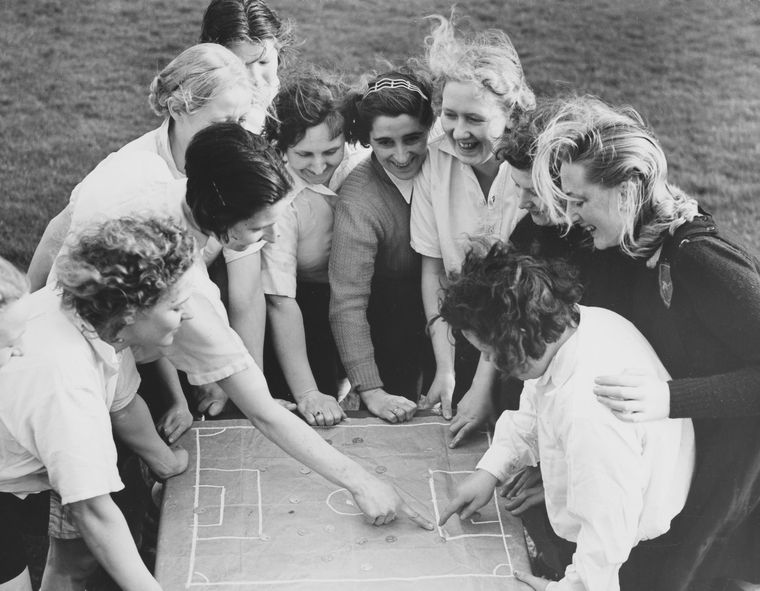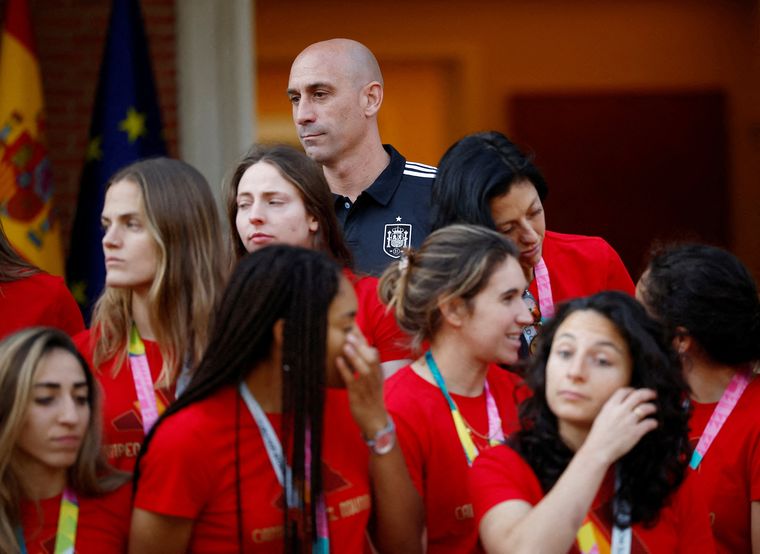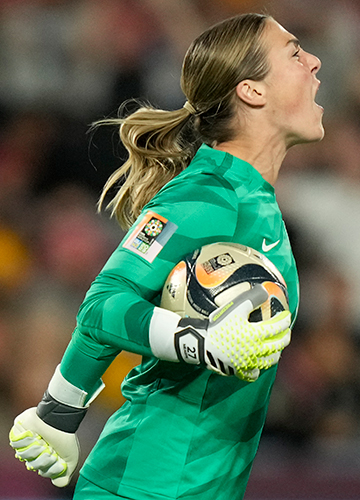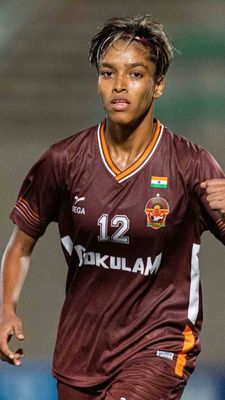Welcome to the jungle, Lionesses... The Daily Telegraph (Sydney) wrote this August, leaking photos of the England women’s football team training. The Lionesses were preparing to take on the Australian Matildas in the semifinals of the 2023 FIFA Women’s World Cup. The newspaper had used a helicopter to shoot the photos, considering the interest at home around the match, and perhaps hoping that filming the tactical setup could give the beloved Matildas some advantage.
It did not. Australia, ranked tenth, lost 3-1 to European champions England (ranked fourth), and finished fourth in the World Cup after losing to third-ranked Sweden in the third-place match. It was the best ever showing by an Australian soccer team at senior level and it prompted the government to pledge A$200 million (around Rs1,100 crore) to improve women’s sporting facilities. More significantly, the women’s team was the most in-demand sporting entity in the sports-obsessed nation in the buildup to the semifinal match.
Their matches broke viewership records and the semifinal turned out to be the most watched TV programme in the country. The research firm OzTAM said it had a peak viewership of 11.15 million. The Seven Network delayed its main news bulletin to show the match, and the men’s Australian rules football league screened it at the stadium before a derby match. In the days before the match, women’s jerseys outsold the men’s kits two to one.
Things, however, were different a while ago.
There was a time when the women players had to create and hand out flyers to attract spectators. They even had to beg TV stations to telecast their matches.

The change was ignited by a determined campaign in the 2007 World Cup in China. Then ranked 15th, the Matildas thrashed Ghana and drew with Norway (ranked 4) and with Canada (ranked 9) to qualify for the knockout rounds for the first time. In the quarterfinals, they lost a hard-fought match (3-2) to eventual runners-up Brazil.
The performance inspired the establishment of a women’s league in Australia and that, in turn, has created a pathway for the emergence of current stars, like captain Sam Kerr―widely regarded as the best striker in the world today. The Matildas now sell out stadiums and have achieved pay parity. They exemplify the sea change the women’s game has undergone in recent years.
This change is reflected even in the generally toxic football ecosystem of England―there is greater acceptance of, and far more media coverage for, the women’s team. The investment in women’s football in recent years has been rewarded rather fast. When the Lionesses won the Euros in 2022, it was the first senior football title won by England since the men won the World Cup in 1966. Their run to the final of the 2023 World Cup, despite losing key players to injuries, was mighty impressive in more ways than one. Perhaps, the resilience the team showed was not surprising. After all, the women’s game in the country has dealt with setbacks for over a century.
The first recorded women’s football game was played on May 7, 1881, between teams representing Scotland and England (the nationalities of players have been contested). Women’s football refused to die down despite palpable contempt from the press and the public thanks largely to the efforts of a few. It also helped to attract attention to women’s rights movements, such as the campaign for suffrage. Years later, during World War I, with men sent to the front, women flooded into the factories and the women’s game grew leaps and bounds as factories started more women’s teams. By 1921, there were about 150 women’s clubs. Matches were gaining in popularity, with more than 50,000 fans watching a game at Goodison Park, home of Everton Football Club in Liverpool.

But, success would be the downfall of women’s football. “The Football Association and the political establishment were not blind to the growing popularity and success of women’s football,” writes Suzanne Wrack in A Woman’s Game: The Rise, Fall, and Rise Again of Women’s Football. “The huge sums of money being raised were outside their jurisdiction. Worse still, that money was no longer being raised to support the war wounded but was being channelled into political and working-class causes―antithetical to the establishment.” So, the FA banned women’s matches from affiliated grounds. The ban would stand for 50 years. And, despite the determination of women to keep playing―they played in public parks, rugby grounds and smaller venues―without the capacities and facilities of affiliated grounds, the women’s game was sidelined and eventually overshadowed by the men’s game. It took the FA 87 years to apologise for setting back the women’s game.
In 2018, ten years after the FA apologised, FIFA, which had organised the Women’s World Cup since 1991, launched its women’s football strategy. It has been, on most counts, a resounding success. For example, in 2020, FIFA announced that member associations could apply for its support across eight key areas of women’s football development. In addition to financial assistance to cover costs of select programmes, FIFA would provide access to experts and equipment and technical support. The initiative has led to more than 900 projects being delivered in 137 associations. A key objective of FIFA’s strategy was to increase the appeal of the women’s game to players, fans and sponsors. Going by recent numbers, this is being achieved, too.
In 2019, record attendances for women’s club matches were set in England, Spain, Italy and Mexico. In 2022, Barcelona Femení broke the world record for attendance at a women’s football match twice within a month, with crowds of 91,000-plus. At the 2023 World Cup, about two million fans attended the matches and FIFA’s social and digital platforms got more than three billion views. TV viewership is estimated to have hit 2 billion, up from 1.12 billion in 2019.
The viewership records set during the Women’s World Cup was a sort of culmination of gradual trends observed in the past few years. For example, viewership in the UK rose from 11.7 million in 2017 to 68.6 million in 2019, as per Nielsen. In 2022, some 57.9 million people watched the Euros. Nielsen’s assessment of 2023 is that fans, especially younger ones, want to follow women’s sports and are ready to reward brands, sponsors and broadcasters who invest in women’s sports. This intent to spend is already visible in the finances of women’s clubs. As per the FIFA Women’s Benchmarking Report 2023, the average operating revenue of women’s clubs grew by 133 per cent to $785,000 (around Rs6.5 crore) in 2021-22 compared with 2020-21.
The growth of women’s football globally is also marked by the increased activity of women’s national teams. The number of officially ranked teams increased from 155 in 2019 to 188 in 2023. So did the number of teams participating in World Cup qualifiers―from 140 for the 2019 edition to 168 ahead of 2023. Moreover, the appeal of the women’s game to commercial partners became evident when all the partnership packages for the World Cup were sold out on the day they were made available. The number of partners increased to 30, from 12 in 2019.
Most importantly, the number of women and girls playing organised football grew by nearly a quarter compared with 2019 (up to 16.6 million). As many as 88 per cent of national associations surveyed by FIFA now report having a women’s football strategy.
“This year, we have felt a seismic shift in the way that people see the women’s game,” said Sarai Bareman, FIFA Chief Women’s Football Officer in August. “2023 is about showing the world what it means to take the game beyond greatness. To put players on the pedestal [where] they belong, to fill the stadiums, smash records... break down barriers and show every young girl and boy, from every corner of the world that they can dream to make a living from football.”
Clearly, FIFA has come a long way from the days of its infamous former president Sepp Blatter saying that women needed to play in tighter attire to attract audiences. But, there is still a lot to be done.
For instance, one in five players at the 2023 World Cup received discriminatory, abusive or threatening messaging on social media. Almost 50 per cent of the abusive messages was homophobic, sexual and sexist abuse. Most tellingly, as per FIFA, the women were 29 per cent more likely to be targeted with online abuse compared with players at the 2022 Men’s World Cup.

The US women’s national team―currently ranked third, but the most successful team in international women’s football―had to sue for equal pay, despite bringing in more revenue than the men’s team. The case ended with a $24 million settlement in 2022.
Another notable case is that of England and Manchester United goalkeeper Mary Earps, who was voted the best goalkeeper in the world in 2022 and won the golden glove at the 2023 World Cup. Replicas of her England goalkeeper shirt were not available to fans ahead of the World Cup, because “producing women’s goalkeeper kits for the public” was not a part of Nike’s business strategy. This despite the fact that her club kits had sold out the previous season. Earps admitted that she was hurt. And a public outcry followed. Soon 1.7 lakh people signed a petition calling for Nike to change its mind. The brand had no option but oblige.

The 2023 World Cup also saw then Spanish football federation president, Luis Rubiales, kissing Spain’s all-time top goalscorer Jenni Hermoso on her lips without her consent during the presentation ceremony after the team’s triumph. English football administrator Debbie Hewitt also accused Rubiales of forcefully kissing an English player and cupping and stroking the face of another during the same ceremony. The Spanish players have had other fights against the federation in recent years, but the men in power had always managed to survive the fallout. This time would be different. Rubiales’s actions led to the #SeAcabó (it’s over) movement. It became a platform for women in the country to speak about sexual harassment and everyday sexism, and focused on preventing sexual violence by “powerful men and abusive bosses”. And, eventually, after feeble and disturbing attempts to defend himself, Rubiales was forced to resign. FIFA banned him from football for three years.
Though the problems in these three cases were different―ranging from neglect to indifference to assault―one thing was common. The women who raised their voices were heard and they found support, mostly from the younger generation, forcing the powers that be to act. It was no longer feasible to ignore them.
This year saw the momentum that had been slowly building over the past few years converting into a surge forward. And, for this reason, 2023 is likely to be remembered by future generations as a turning point for women’s football. Already, many nations around the world have got dividends for investments in women’s football.
Morocco is arguably the best example. The team was ranked 72nd before the 2023 World Cup, but it managed to progress to the round of 16.
India, too, is keen to ride this wave and give the Blue Tigresses a fighting chance as they compete in the international arena. Satyanarayan M., acting secretary general of the All India Football Federation, told THE WEEK that the focus was on developing the entire women’s football ecosystem in the country. “One of the first things that we have done, and something that will be there for all to see this season, is that we have expanded the Indian Women’s League,” he said. “At the grassroots level, there is The Blue Cubs project to identify elite talent between the ages of 8 and 12 and bring them into the system of the junior leagues and national football championships.”
Encouragingly, in recent years, Indian players have been getting more opportunities to play overseas. Goalkeeper Aditi Chauhan from Delhi was with Premier League club West Ham United’s ladies team. In 2020, Manipur’s Bala Devi, India’s leading goalscorer, became the first Indian woman to score in a European league by netting for Glasgow Rangers Women. In 2022, Manipur attacker Dangmei Grace joined Uzbek club PFC Sevinch Karshi and won both the league and cup. Forward Manisha Kalyan, from Haryana, did the same with Cypriot club Apollon Ladies this year. Manisha, the reigning AIFF Women’s Player of the Year, also became the first Indian to play in Europe’s premier club competition for women’s teams―the UEFA Women’s Champions League.
But, even amid such massive strides, there are big setbacks, too. For example, India’s best supported football club, the Kerala Blasters, “temporarily halted” their women’s team this year to cope with a fine that the men’s team got. They were widely criticised and even their ever-loyal fans expressed disappointment, with fan group Manjapadda terming it a “pathetic decision from the management”. The choice made by the team begs the question whether the AIFF should get involved to avoid such occurrences in the future. One option is to make it mandatory for all the clubs competing in the first division to have a women’s team and youth teams.
However, Satyanarayan said that was not the solution. “Having a women’s team just for the sake of it will not improve anything in the long run,” he said. “There has to be intent and effort put into running a football team. That is why we believe mandating clubs to have a women’s team would be rather counterproductive to our efforts.” He said that the AIFF’s approach was to bring about a scenario where the clubs see the benefits of having a women’s team, winning the Indian Women’s League and playing international competitions. “Gokulam Kerala FC have played a couple of times in the AFC (Asian) Women’s Club Championship and they have represented India proudly,” he said. “It is our hope that other clubs see the merit of this and take up the cause of women’s football in their catchment areas.”





